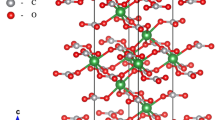Abstract
New phases formed at high pressure and temperature can be successfully quenched to ambient conditions if the kinetics of the back transformation are slow. One important application of this technique is to mineral physics — the combination of microscopic measurements of the structural, physical and chemical properties of high-pressure minerals measured in the laboratory with macroscopic geophysical and geochemical data to produce a unified description of the Earth's interior. The dominant high-pressure phases inferred to be present in the Earth's mantle have been synthesised using a multi-anvil press to correlate structural and chemical information obtained from Mössbauer data with bulk geophysical and geochemical data to determine properties of the mantle, such as the oxidation state. Results from experiments on the major transition zone minerals β−(Mg, Fe)2SiO4, (Mg, Fe)SiO3 garnet and γ−(Mg, Fe)2SiO4 spinel include the discovery of significant Fe3+ in these phases synthesised in equilibrium with metallic iron and excess silica, implying that the oxygen fugacity (fO2) of the transition zone must be substantially lower than the upper mantlefO2. Mössbauer spectra of the lower mantle phase (Mg, Fe)SiO3 perovskite show that Fe2+ occupies the large distorted site almost exclusively, and that significant Fe3+ is present at the minimum fO2 stability limit. Low temperature spectra indicate a phase transition possibly corresponding to a distortion of the perovskite structure. Mössbauer spectra of FexO quenched from high pressure indicate that the Fe3+ content of samples in equilibrium with metallic iron is small, implying that the minimum amount of Fe3+ in the lower mantle (Mg, Fe)O at lower mantle conditions is also small. Mössbauer spectra from samples of (Mg, Fe)O synthesised at different temperatures andfO2 conditions show that the Fe3+ content can be reliably measured, and that it varies significantly withfO2. Implications of these results to properties of the Earth's interior are discussed.
Similar content being viewed by others
References
F. Birch, J. Geophys. Res. 57(1952)227.
R.J. Hemley, P.M. Bell and H.K. Mao, Science (1987) 605.
S. Akimoto, in:High Pressure Research in Mineral Physics, eds. M.H. Manghnani and Y. Syono (Terra Scientific Publ., Tokyo / Am. Geophys. Union, Washington D.C., 1987) p. 1.
R.C. Liebermann and Y. Wang, in:High Presure Research: Application to Earth and Planetary Sciences, eds. Y. Syono and M.H. Manghnani (Terra Scientific Publ., Tokyo / Am. Geophys. Union, Washington D.C., 1992) p. 19.
H. St. C. O'Neill, D.C. Rubie, D. Canil, C.A. Geiger, C.R. Ross II, F. Seifert and A.B. Woodland, in:Evolution of the Earth and Planets, Geophysical Monograph 74, eds. E. Takahashi, R. Jeanloz and D.C. Rubie (Am. Geophys. Union, Washington D.C., 1993) p. 73.
C.A. McCammon, in:Handbook of Physical Constants, ed. T.J. Ahrens (Am. Geophys. Union, Washington D.C, 1994), in press.
C.A. McCammon, V. Chaskar and G.G. Richards, Meas. Sci. Tech. 2(1991)657.
C.A. McCammon, these proceedings, Hyp. Int.
H. St. C. O'Neill, C.A. McCammon, D. Canil, DC. Rubie, C.R. Ross II and F. Seifert, Am. Mineral. 78(1993)456.
C.A. McCammon, D.C. Rubie, C.R. Ross II, F. Seifert and H. St. C. O'Neill, Am. Mineral. 77(1992)894.
C. McCammon, Science 259(1993)66.
B.J. Wood, L.T. Bryndzia and K.E. Johnson, Science 248(1990)337.
H.G. Huckenholz, J.F. Schairer and H.S. Yoder, Jr., Carnegie Inst. Wash. Yearbook 66(1966)335.
A. Nakamura and H. Schmalzried, Phys. Chem. Minerals 10(1983)27.
H. Horiuchi, E. Ito and D.J. Weidner, Am. Mineal. 72(1987)357.
W.E. Jackson, E. Knittle, G.E. Brown, Jr. and R. Jeanloz, Geophys. Res. Lett. 14(1987)224.
R. Jeanloz, B. O'Neill, M.P. Pasternak, R.D. Taylor and S.R. Bohlen, Geophys. Res. Lett. 19(1992)2135.
J.B. Parise, Y. Wang, A. Yeganeh-Haeri, D.E. Cox and Y. Fei, Geophys. Res. Lett. 17(1990)2089.
Y. Kudoh, C.T. Prewitt, L.W. Finger, A. Daroviskikh and E. Ito, Geophys. Res. Lett. 17(1990)1481.
E. Dowty and D.H. Lindsley, Am. Mineral. 58(1973)850.
Y. Zhao, D.J. Weidner, J.B. Parise and D.E. Cox, Phys. Earth Planet. Inter. 76(1993)1.
Y. Zhao, D.J. Weidner, J.B. Parise and D.E. Cox, Phys. Earth Planet. Inter. 76(1993)17.
N.L. Ross and R.M. Hazen, Phys. Chem. Minerals 16(1989)415.
Y. Kudoh, E. Ito and H. Takeda, Phys. Chem. Minerals 14(1987)350.
N.L. Ross and R.M. Hazen, Phys. Chem. Minerals 17(1990)228.
X. Li and R. Jeanloz, J. Geophys. Res. 96(1991)6113.
J.P. Poirer and J. Peyronneau, in:High Pressure Research: Application to Earth and Planetary Sciences, eds. Y. Syono and M.H. Manghnani (Terra Scientific Publ., Tokyo / Am. Geophys. Union, Washington D.C, 1992) p. 77.
R. Datt and K.J. Muirhead, Phys. Earth Planet. Inter. 15(1977)28.
K.J. Muirhead and A.L. Hales, Earth Planet. Inter. 23(1980)304.
J.A. Tossell, Am. Mineral. 61(1976)130.
R.A. Giddings and R.S. Gordon, J. Am. Ceram. Soc. 56(1973)111.
C.A. McCammon and L. Liu, Phys. Chem. Minerals 10(1984)106.
C. McCammon, Science 261(1993)924.
C.A. McCammon and D.C. Price, Phys. Chem. Minerals 11(1984)250.
C.A. McCammon, J. Magn. Magn. Mater. 104–107(1992)1937.
C.A. McCammon and Q.A. Pankhurst, these Proceedings, Hyp. Int.
I. Srečec, A. Ender, E. Woermann, W. Gans, E. Jacobsson, G. Eriksson and E. Rosén, Phys. Chem. Minerals 14(1987)492.
F. Guyot, M. Madon, J. Peyronneau and J.P. Poirier, Earth Planet. Sci. Lett. 90(1988)52.
P. Valet, W. Pluschkell and H. Engell, Arch. Eisenhüttenwes. 46(1975)383.
A.M. Dziewonski and D.L. Anderson, Phys. Earth Planet. Inter. 25(1981)297.
E. Ito and E. Takahashi, in:High Pressure Research in Mineral Physics, eds. M.H. Manghnani and Y. Syono (Terra Scientific Publ., Tokyo / Am. Geophys. Union, Washington D.C., 1987) p. 221.
Author information
Authors and Affiliations
Rights and permissions
About this article
Cite this article
McCammon, C.A. Mössbauer spectroscopy of quenched high-pressure phases: Investigating the Earth's interior. Hyperfine Interact 90, 89–105 (1994). https://doi.org/10.1007/BF02069120
Issue Date:
DOI: https://doi.org/10.1007/BF02069120




